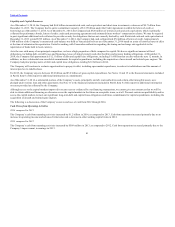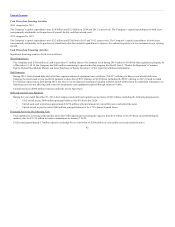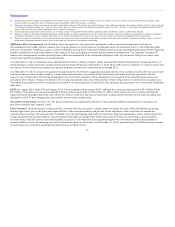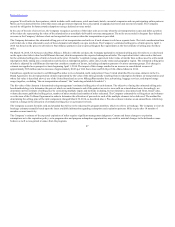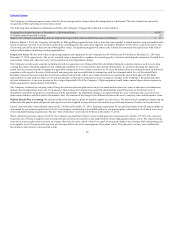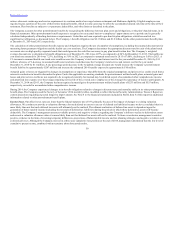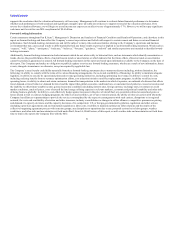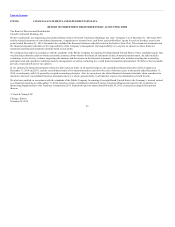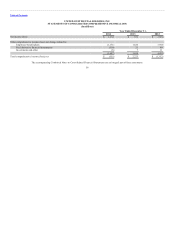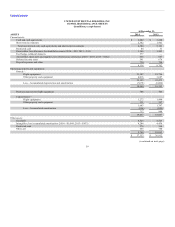United Airlines 2014 Annual Report Download - page 50
Download and view the complete annual report
Please find page 50 of the 2014 United Airlines annual report below. You can navigate through the pages in the report by either clicking on the pages listed below, or by using the keyword search tool below to find specific information within the annual report.
Table of Contents
retirees who meet certain age and service requirements to continue medical coverage between retirement and Medicare eligibility. Eligible employees are
required to pay a portion of the costs of their retiree medical benefits, which in some cases may be offset by accumulated unused sick time at the time of their
retirement. Plan benefits are subject to co-payments, deductibles, and other limits as described in the plans.
The Company accounts for other postretirement benefits by recognizing the difference between plan assets and obligations, or the plan’s funded status, in its
financial statements. Other postretirement benefit expense is recognized on an accrual basis over employees’ approximate service periods and is generally
calculated independently of funding decisions or requirements. United has not been required to pre-fund its plan obligations, which has resulted in a
significant net obligation, as discussed below. The Company’s benefit obligation was $2.1 billion and $1.8 billion for the other postretirement benefit plans
at December 31, 2014 and 2013, respectively.
The calculation of other postretirement benefit expense and obligations requires the use of a number of assumptions, including the assumed discount rate for
measuring future payment obligations and the health care cost trend rate. The Company determines the appropriate discount rate for each of the plans based
on current rates on high quality corporate bonds that would generate the cash flow necessary to pay plan benefits when due. The Company’s weighted
average discount rate to determine its benefit obligations as of December 31, 2014 was 4.07%, as compared to 4.94% for December 31, 2013. The health care
cost trend rate assumed for 2014 was 7.25%, declining to 5.0% in 2023, as compared to assumed trend rate for 2015 of 7.00%, declining to 5.0% in 2023. A
1% increase in assumed health care trend rates would increase the Company’s total service and interest cost for the year ended December 31, 2014 by $13
million; whereas, a 1% decrease in assumed health care trend rates would decrease the Company’s total service and interest cost for the year ended
December 31, 2014 by $11 million. A one percentage point decrease in the weighted average discount rate would increase the Company’s postretirement
benefit liability by approximately $247 million and increase the estimated 2014 benefits expense by approximately $10 million.
Actuarial gains or losses are triggered by changes in assumptions or experience that differ from the original assumptions and prior service credits result from a
retroactive reduction in benefits due under the plans. Under the applicable accounting standards for postretirement welfare benefit plans, actuarial gains and
losses and prior service credits are not required to be recognized currently, but instead may be deferred as part of accumulated other comprehensive income
and amortized into expense over the average remaining service life of the covered active employees or the average life expectancy of inactive participants. At
December 31, 2014 and 2013, the Company had unrecognized actuarial gains for postretirement welfare benefit plans of $233 million and $555 million,
respectively, recorded in accumulated other comprehensive income.
During 2014, the Company experienced changes in its benefit obligations related to changes in discount rates and mortality tables in its other postretirement
benefit plans. The Company used the Society of Actuaries’ 2014 mortality tables, modified to reflect the Social Security Administration Trustee’s Report on
current projections regarding expected longevity improvements. See Note 8 to the financial statements included in Part II, Item 8 of this report for additional
information related to other postretirement benefit plans.
Income Taxes. Our effective tax rates are lower than the federal statutory rate of 35% primarily because of the impact of changes to existing valuation
allowances. We continue to provide a valuation allowance for our deferred tax assets in excess of deferred tax liabilities because we have concluded that it is
more likely than not that such deferred tax assets will ultimately not be realized. The ultimate realization of deferred tax assets is dependent upon the
generation of future taxable income (including the reversals of deferred tax liabilities) during the periods in which those deferred tax assets will become
deductible. The Company’s management assesses available positive and negative evidence regarding the Company’s ability to realize its deferred tax assets
and records a valuation allowance when it is more likely than not that deferred tax assets will not be realized. To form a conclusion, management considers
positive evidence in the form of reversing temporary differences, projections of future taxable income and tax planning strategies and negative evidence such
as historical losses. Although the Company was not in a three-year cumulative loss position at the end of 2014, management determined that the low level of
cumulative pretax income, combined with uncertainty about forecasted results,
50



